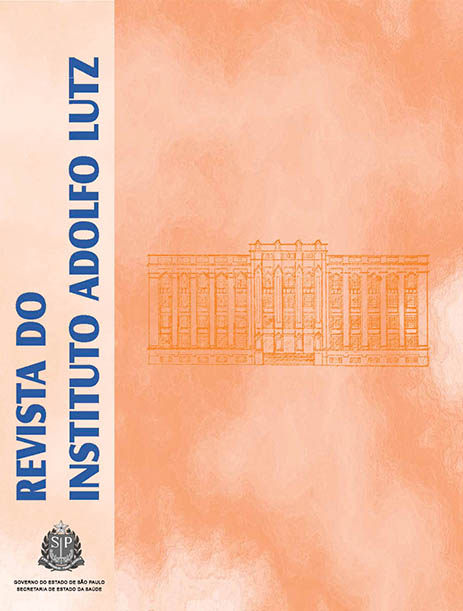Abstract
This study evaluated the methodology for determining bisphenol A (BPA) in mineral water by using the solid phase extraction (SPE), the derivatization with trifluoroacetic anhydride (TFAA), and the gas chromatography with electron capture detector (GC/ECD) analysis. The analytical curve provided the correlation coefficient (R) of 0.999, and the recovery values from 88 to 106%. The limit of detention was 2.5 and the limit of quantification was 25.0 ng.mL-1. Four mineral water samples from different brands were analyzed by this methodology and among them only one (sample 3) showed detectable result of 0.46 ng.mL-1. This study suggested that BPA could be easily detected and quantified in mineral water samples by employing the proposed methodology, which was selective, accurate and precise.References
1. Biles JE, Mcneal TP, Begley TH, Hollifield HC.Determination of bisphenol A in reusable polycarbonate food-contact plastics and migration to food-simulating liquids. J Agric Food Chem. 1997;45:3541-4.
2. Goloubkova T, Spritzer PM. Xenoestrogênios: o exemplo do bisfenol-A. Arq Bras Endocrinol Metab. 2000;44:323-30.
3. Fürhacker M, Scharf S, Weber H. Bisphenol A: emissions from point sources. Chemosphere. 2000;41:751-6.
4. Staples CA, Dorn PB, Klecka GM, O’Block ST, Haris LR. A review of the environmental fate, effects, and exposures of bisphenol A. Chemosphere. 1998;36:2149-73.
5. Leandro FZ, Marchi MR. Bisphenol A: emissions from point sources. Chemosphere. 2000;41(5):751-6.
6. Nira BJ, Steinmetz R. Xenoestrogens: the emerging story of bisphenol A. Trends Endocrinol Metabol. 1998;9:124-8.
7. Bisphenol A. The New York Times. [acesso em 2012 jul 18]. Disponível em: [http://topics.nytimes.com/top/reference/timestopics/subjects/b/bisphenol_a/index.html].
8. Krishnan AV, Starhis PS, Permuth F, Tokes L, Feldman D. Bisphenol-A: an estrogenic substance is released from polycarbonate flasks during autoclaving. Endocrinology. 1993;132:2279-86.
9. Brotons JA, Olea-Serrano MF, Villalobos M, Pedraza V, Olea N. Xenoestrogens released from lacquer coatings in food cans. Environ Health Perspect. 1995;103:608-12.
10. Yamamoto T, Yasuhara A. Determination of bisphenol A migrated from polyvinyl choride hoses by GC/MS. Bunseki Kagaku. 2000;49:443-7.
11. Kuo HW, Ding WH. Trace determination of bisphenol A and phytoestrogens in infant formula powders by gas chromatography-mass spectrometry. J Chromatogr A. 2004;1027:67-74.
12. Zafra A, Olmo M, Suárez B, Hontoria E, Navalón A, Vílchez JL. Gas chromatographic-mass spectrometric method for the determination of bisphenol A and its chlorinated derivatives in urban wastewater. Water Res. 2003;37:735-42.
13. Muerza AF. Impacto ambiental del agua embotellada. [acesso em 2012 jul 18]. Disponível em: [http://www.consumer.es/web/es/medio_ambiente/urbano/2007/05/13/162594.php].
14. Brede C, Fjeldal P, Herikstad H. Increased migration levels of bisphenol A from polycarbonate baby bottles after dishwashing, boiling and brushing. Food Addit Contam. 2003;20:684-89.
15. Kang JH, Kondo F, Katayama Y. Human exposure to bisphenol A. Toxicology. 2006;226:79-89.
16. Le HH, Carlson EM, Chua JP, Belcher SM. Bisphenol A is released from polycarbonate drinking bottles and mimics the neurotoxic actions of estrogen in developing cerebellar neurons. Toxicol Lett. 2008;176:149-56.
17. Fox JE, Gulledge J, Englhaupt E, Burow ME, McLachlan JA. Pesticides reduce symbiotic efficency of nitrogen-fixing rhizobia and host plants. PNAS. 2007;104:10282-7.
18. Costa LA. Desenvolvimento e validação de metodologia de análise de bisfenol A em amostras de águas naturais por CG-EM [dissertação de mestrado]. Campo Grande (MS): Universidade Federal de Mato Grosso do Sul; 2008.
19. Ribani M, Bottoli CBG, Collins CH, Jardim ICSF, Melo LFC. Validação em métodos cromatográficos e eletroforéticos. Quim Nova. 2004;27:771-80.
20. Brito NM, Amarante Junior OP, Polese L, Ribeiro ML. Validação de métodos analíticos: estratégia e discussão. Pesticidas: R Ecotox Meio Ambiente. 2003;13:129-46.
21. Brasil. Agência Nacional de Vigilância Sanitária (ANVISA). Resolução RE nº 899, de 29 de maio de 2003. Aprova o Guia para validação de métodos analíticos e bioanalíticos. Diário Oficial da União, Brasília (DF); 2 jun 2003; Seção 1.
22. Sociedade Brasileira de Química (SBQ) – Regional Rio de Janeiro. Canadá proíbe o uso de policarbonato na confecção de mamadeiras a partir de 2009. [acesso em 18 jul 2012]. Disponível em: [http://www.uff.br/sbqrio/novidades/bisfenol%20policarbonato%20mamadeira.html].
23. Official Journal of the European Union. Commission Directive 2004/19/EC of 1 March 2004 amending Directive 2002/72/EC relating to plastic materials and articles intended to come into contact with foodstuffs. [acesso em 2012 jul 18]. Disponível em: http://www.food.gov.uk/multimedia/pdfs/commdir200419ec.pdf
24. Brasil. Ministério do Meio Ambiente. Conselho Nacional do Meio Ambiente (CONAMA). Resolução nº 430, de 13 de maio de 2011. Dispõe sobre as condições e padrões de lançamento de efluentes, complementa e altera a Resolução nº 357, de 17 de março de 2005, do Conselho Nacional do Meio Ambiente-CONAMA. Diário Oficial da União, Brasília (DF); 16 maio 2011; Seção 1:89.

This work is licensed under a Creative Commons Attribution 4.0 International License.
Copyright (c) 2012 Instituto Adolfo Lutz Journal
